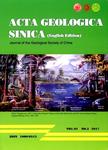The Zhaxikang Vein-type Pb-Zn-Ag-Sb Deposit in Himalayan Orogen, Tibet: Product by Overprinting and Remobilization Processes during Post-collisional Period
The Zhaxikang Vein-type Pb-Zn-Ag-Sb Deposit in Himalayan Orogen, Tibet: Product by Overprinting and Remobilization Processes during Post-collisional Period作者机构:Chengdu Center China Geological Survey Chengdu 610082 China Institute of Geology Chinese Academy of Geological Sciences Beijing 100037 China China university of geosciences Beijing 100037 China Institute of Mineral Resources Chinese Academy of Geological Sciences Beijing 10003 7 China
出 版 物:《Acta Geologica Sinica(English Edition)》 (地质学报(英文版))
年 卷 期:2018年第92卷第2期
页 面:682-705页
核心收录:
学科分类:0709[理学-地质学] 0819[工学-矿业工程] 081803[工学-地质工程] 08[工学] 0818[工学-地质资源与地质工程] 0708[理学-地球物理学] 0816[工学-测绘科学与技术]
基 金:supported by grants from the Ministry of Science and Technology of China(National Key Research and Development Project of China:2016YFC0600308) a Program of the China Geological Survey(DD20160015) NSFC(41702086&41503040)
主 题:polymetallic multiple period and stage mineralization overprinting and remobilization,orogenic belt Zhaxikang Tibet
摘 要:The Zhaxikang Pb-Zn-Ag-Sb deposit, the largest polymetallic deposit known in the Himalayan Orogen of southern Tibet, is characterized by vein-type mineralization that hosts multiple mineral assemblages and complicated metal associations. The deposit consists of at least six steeply dipping vein- type orebodies that are hosted by Early Jurassic black carbonaceous slates and are controlled by a Cenozoic N-S-striking normal fault system. This deposit records multiple stages of mineralization that include an early period (A) of massive coarse-grained galena-sphalerite deposition and a later period (B) of Sb-bearing vein-type mineralization. Period A is only associated with galena-sphalerite mineralization, whereas period B can be subdivided into ferrous rhodochrosite-sphalerite-pyrite, quartz -sulfosalt-sphalerite, calcite-pyrite, quartz-stibnite, and quartz-only stages of mineralization. The formation of brecciated galena and sphalerite ores during period A implies reworking of pre-existing Pb -Zn sulfides by Cenozoic tectonic deformation, whereas period B mineralization records extensive open- space filling during ore formation. Fluid inclusion microthermometric data indicate that both periods A and B were associated with low-medium temperature (187-267℃) and low salinity (4.00-10.18% wt. NaCl equivalent) ore-forming fluids, although variations in the physical-chemical nature of the period B fluids suggest that this phase of mineralization was characterized by variable water/rock ratios. Microprobe analyses indicate that Fe concentrations in sphalerite decrease from period A to period B, and can be divided into three groups with FeS concentrations of 8.999-9.577, 7.125-9.109, 5.438-1.460 mol.%. The concentrations of Zn, Sb, Pb, and Ag within orebodies in the study area are normally distributed in both lateral and vertical directions, and Pb, Sb, and/or Ag concentrations are positive correlation within the central part of these orebodies, but negatively correlate in th



